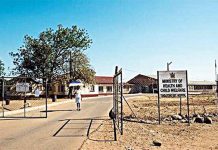His right hand still needs physiotherapy four months after being discharged from hospital, where he was admitted for a month after travelling 140km from Sigare village in Chegutu district to a referral hospital in Harare. All health facilities in the district could not assist him because of lack of resources to establish the extent of his injuries.
Aclas, in the company of his father Gilbert and his 19-year-old brother Allen who was also born with a hearing impairment, is about to go through a testing process by an audiologist from the Ministry of Primary and Secondary Education (MoPSE) to ascertain the level of hearing loss and monitor if the ears had an infection that needs treatment first before a hearing aid can be recommended.
An audiologist deals with hearing disorders, including assessment of hearing function and rehabilitation of patients with hearing impairments.

Aclas, who is in grade 3 at Amiva Primary school, explains: “I was going to school with my friend. We crossed the road together. I wanted to go back to pick up my toy (a toy car made of scrap aluminium wire) that I had left on the other side of the road. I did not hear any car approaching and it hit me on my right side. Sometimes I feel pain.”
Aclas takes a moment to play with his frayed shoelaces. His toe protrudes from his left shoe. He is wearing a grey school shirt and a black pair of trousers whose stiches have given way to reveal his skin. The clothes are a revelation of abject poverty, a life without basic necessities.
His father speaks about the challenges his two children faced growing up in Sigare, a resettlement village situated 10km from Chegutu town: “Sometimes he (Aclas) gets aggressive when he is playing with others. This, I discovered, is because he gets frustrated when he cannot hear what his friends are saying. I have seven children and these two here have hearing problems. I am too poor to take them to a professional for assistance. I survive on subsistence farming. He is excited at the prospect of getting hearing aids, and it is unfortunate that I cannot do more than hope for a good outcome today.”
Aclas declares that he would like to be either a doctor or a teacher when he grows up: “The teacher makes me sit in front in class. Sometimes I do not understand what she is saying.
Ironically, his 19-year-old brother was also involved in an accident when he was hit by a car last year, cycling for 10 km to attend school at St Francis Primary school which has a Hearing Impairment resource unit with teachers who are qualified in special needs education
“Allen was referred to the resource unit when he was 15 and the nearest and only school for those hard of hearing is St Francis Primary, which is 10 km away from our home. Last year he was also involved in accident, but was not hurt much. But the trauma of the incident forced him to drop out of school,” Gilbert said.
Hearing test
At St Francis Primary school, a sizeable number of children with hearing impairments, accompanied by their parents, sit outside wooden benches, shielded by mango trees from the searing heat of November. Mercy Mutare, the national audiologist summons Aclas for initial testing.
She will be doing the testing on children in three districts of Mashonaland West province that she recommended last July for further otoscopy (ear examination). She is particularly excited that UNICEF acquired advanced digital hearing aids which are beyond the economic power of most parents.
In 2017, UNICEF Zimbabwe procured 400 digital hearing aids for MoPSE, which are currently being fitted to school-age children. The fitting process is now in the second stage. Since identified children are more than 400, UNICEF ordered an additional 400 hearing aids this year. The devices were procured thanks to the Education Development Fund (EDF II), 2012-2020: a multi-donor pooled funding mechanism supported by UK aid from the UK government and the German Development Bank (KfW).
A twiddling and excited Aclas wears head phones that are attached to an audiometer machine.
Mercy explains: “This machine evaluates hearing loss. The machine delivers pure tones of controlled intensity to one ear and Aclas must respond when he picks a sound by raising up his hand. This helps to determine the level of hearing and informs the programming of the digital hearing aid to specific need.”
The difference between the analogue hearing aids that needed a screw drive to adjust sound was the inaccuracy of the amplification and generally batteries did not last long. The digital aids have computer software that allows an audiologist to programme and set the level of sound specific to individual need.
In addition, analogue hearing aids amplify all sounds equally including background noise. On the other hand, digital hearing aids can amplify or eliminate a specific frequency thereby improving clarity of sound.
On hearing the sounds in his ear, Aclas smiles and enthusiastically raises his hand each time a beep from the machine registers.
Mercy has determined that his right ear can benefit from a hearing aid because his left has been adjudged to have profound hearing loss, and she lets him know. His father, who was monitoring the process, smiles even as he is overwhelmed by emotion he thanks UNICEF and the audiologist.
His father calls Aclas by name from a distance of about three meters and he immediately responds. He is in a state of euphoria as he holds his right ear as if in doubt of the voices that are now amplified.
Aclas tells his father. “I will be able to do my homework easily.” Mercy however, recommends that he joins a resource unit for learners with hearing impairment at St Francis to learn Sign Language and speech training, which takes time to learn.”
“He will one day be able to join the mainstream class, but it is important that he be monitored by trained teachers. The hearing aid will now allow him to tell the sounds around him more clearly and avoid life-threatening dangers like the accident that could have easily claimed his life,” Mercy said.
TeacTHE Reserve Bank of Zimbabwe (RBZ) has effectively brought back the local currency after denoting the existing electronic balances, bond notes and coins in circulation as real time gross settlement (RTGS) dollars, making them the official legal tender, as part of a host of monetary policy measures announced yesterday.
The bank has also removed the 1:1 peg on the local currency against the US dollar, practically de-dollarising, in a move which authorities hope will curb growth of the parallel market and ease foreign currency shortages which have crippled business.
In a widely anticipated move, RBZ governor John Mangudya said the legal instrument to give effect to the new legal tender was being prepared and that the central bank would establish an interbank platform, where currency would be traded freely from Monday February 25.
The 2019 budget, which was announced by Finance minister Mthuli Ncube last year, is also denominated in RTGS dollars, he added.
The country adopted mainly the US dollar after dumping its hyperinflation-ravaged currency in 2009, but has been struggling with a shortage of real dollars since 2016.
Previously, the central bank had maintained a fixed exchange rate, where RTGS balances, bond notes and coins were pegged at par with the United States dollar.
But this has largely resulted in intensified acute shortage of foreign exchange, price distortions and heightened inflationary pressures.
Mangudya, who had previously been opposed to the idea of allowing the currency to float freely, said the situation was no longer tenable and needed to be addressed immediately in order to restore the value of money.
“The bank considered the implications — accounting, financial, economic, legal and social — that are embedded in the establishment of an inter-bank forex market within the context of the current national payment systems made up of RTGS, mobile payment platforms, point-of-sale (POS), bond notes and coins.
“After taking into account the implications and putting in place safeguards to maintain stability in the forex market, the bank is, with immediate effect, establishing an inter-bank foreign exchange market in Zimbabwe to formalise the trading of RTGS balances and bond notes with US$ and other currencies on a willing-buyer, willing-seller basis through banks and bureaux de change,” he said.
“Bureaux de change shall be authorised to purchase foreign currency without limits, but shall be limited to sell foreign currency for small transactions such as subscriptions, business and personal travel up to a maximum aggregate daily limit of $10 000. Like with banks, bureaux de change and their agents shall report their activities of the inter-bank on a daily basis as required by the (central) bank.”
Mangudya said the central bank had arranged sufficient lines of credit to underpin the foreign exchange market, but he would not be drawn into disclosing the source of funding or the quantum.
Foreign currency from the interbank market shall be utilised for current bona fide foreign payment invoices except for school fees, he said.
“Foreign currency requirements for government expenditure and other essential commodities that include fuel, cooking oil, electricity, medicines and water chemicals shall continue to be made available through the existing letters of credit facilities and or the foreign exchange allocations committee.
“All foreign liabilities or legacy debts due to suppliers and service providers such as the International Air Transport Association (IATA), declared dividends, etc shall be treated separately after registering such transactions with exchange control for the purposes of providing the bank with sufficient information that will allow it to determine the roadmap for orderly expunging the legacy debt,” the RBZ chief said.
On exports, Mangudya announced that the export incentive scheme, which had been put in place to spur exports, would cease to exist after it was eroded by inflationary pressures.
Both large and small-scale gold producers will continue to retain 55% of their foreign currency earnings, while the rest will be paid in RTGS dollars.
The horticulture, manufacturing, transport and tourism sectors will retain 80% of their export earnings.
Tobacco and cotton merchants for input schemes will also retain 80%, while growers will be allocated 30%.
“Similarly, in order to enhance liquidity within the foreign currency market, exporters shall be entitled to utilise their retained export receipts within 30 days, after which the unutilised export receipts will be offloaded into the market at the prevailing exchange rate,” Mangudya added.
All international remittances and individual funds received from offshore shall continue to be treated as free funds.
In 2018, foreign receipts amounted to $6,3 billion, with export proceeds contributing 68% of the total amount received.
International remittances declined by 19% from $1,4 billion received in 2017 to $1,1 billion received in 2018. Of the $1,4 billion, Diaspora remittances contributed $619,2 million, a decline of 11,4% as compared to $699 million received in 2017.
According to the bank, the decline in Diaspora remittances is mainly attributed to the interception of remittances in South Africa by cross-border traders.
South Africa contributes about 34% of the total Diaspora remittances. Proceeds from loans accounted for 13% of the total foreign receipts.
er speaks out
Dorothy Gondo a teacher for children with hearing impairments said: “Being hearing impaired is a disability that is not visible to an inexperienced eye. So when it comes to school placement, a child can be disadvantaged, resulting in delay in their development educationally. The children end up being traumatised.”
Aclas smiles as he walks out of the make-shift testing centre hand in hand with his brother, his father in tow.
Gilbert sums it up: “It is like he is starting a new life. I hope all parents with children who are disabled will get this kind of assistance that my child has got. It is a new hope.”






